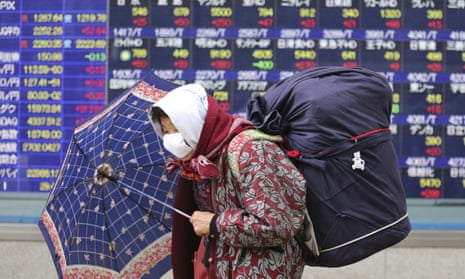Japan’s closed-door immigration policy is expected to come under scrutiny after census data showed that more than a quarter of its population is over 64, while the number of children aged under 14 is at a record low – trends that have caused alarm over the country’s economic fortunes.
People aged 65 or over make up a record 26.7% of Japan’s population of 127 million, according 2015 census data released by the internal affairs ministry – an increase of 3.7 percentage points since the last survey was conducted in 2010.
Government data shows the number of workers in Japan is projected to fall by 7.9 million, or 12.4%, to 55.61 million by 2030. Its overall population will drop to 86 million in 2060, with the proportion of people aged 65 or over reaching nearly 40% of the total.
“The ratio of people aged 65 or older is the highest ever recorded,” a ministry official said, according to the Japan Times. “This is because many baby boomers have entered this age category over the past five years.”
Attempts to raise the birthrate have proved unsuccessful, while policy makers are resistant to the idea of relaxing immigration laws.
However, without a net increase in immigration, the UN projects that Japan’s working-age population will “decline continuously” to 57 million by the middle of the century. It estimates that Japan would need to allow 17 million immigrants to enter the country between 2005 and 2050 to keep its population at 127 million.
Meanwhile, the number of under-15s stands at 15.86 million – a record low of 12.7% of the total population, and a 0.5 percentage point decline from five years ago.
In Akita, a rural prefecture in the north of Japan’s main island, people aged 65 or over comprise 33% of the population, while Okinawa in the country’s far south had the smallest older population, at 19.7% of the total.
People aged 65 and above now outnumber those aged under 15 in every one of Japan’s 47 prefectures, the report said.
Japan has so far refused to consider accepting significant numbers of immigrants to boost the declining workforce, which shrank by almost 3 million people in the five years from 2010.
Now, women and people aged over 64 make up just over 50% of the country’s workforce, featuring prominently in the nursing and welfare sectors, where services are being stretched by the rise in the population of older people.
The prospect of a welfare funding crisis created by a rapidly ageing society came under the spotlight recently after the finance minister, Taro Aso, was heavily criticised for comments about the country’s thrifty pensioners.
Speaking at a rally in northern Japan earlier this month, Aso said: “I recently saw someone as old as 90 on television, saying how they were worried about the future. I wondered, ‘How much longer do you intend to keep living?’”
Aso then urged older people to spend more of their savings to boost the economy. “The biggest problem at the present is how everyone is staying put,” he said, according to Kyodo. “If you don’t spend the money you have, that money will mean nothing. What’s the point of accumulating more wealth? Are you just looking at the money you have?”
In 2013, he suggested elderly people were an unnecessary drain on public finances and said they should be allowed to “hurry up and die” to relieve pressure on the state to pay for their medical care.

Comments (…)
Sign in or create your Guardian account to join the discussion